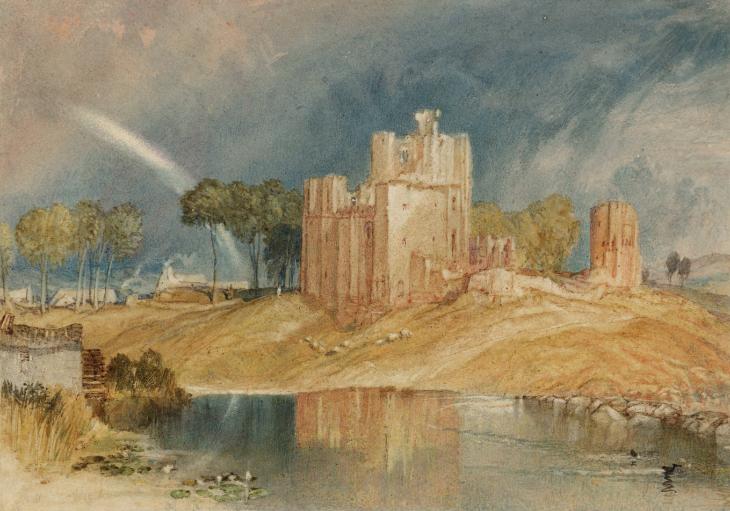Joseph Mallord William Turner Brougham Castle, near the Junction of the Rivers Eamont and Lowther c.1824
Joseph Mallord William Turner,
Brougham Castle, near the Junction of the Rivers Eamont and Lowther
c.1824
Joseph Mallord William Turner 1775–1851
Brougham Castle, near the Junction of the Rivers Eamont and Lowther c.1824
D18147
Turner Bequest CCVIII N
Turner Bequest CCVIII N
Watercolour on white wove watercolour paper, 161 x 228 mm
Blind-stamped with Turner Bequest monogram bottom left
Blind-stamped with Turner Bequest monogram bottom left
Accepted by the nation as part of the Turner Bequest 1856
Exhibition history
1904
National Gallery, London, various dates to at least 1904 (174).
1934
Four Screens, British Museum, London, July 1934–1935 (no catalogue).
1971
Watercolours by J.M.W. Turner (1778 [sic]–1851): Lent by the Trustees of the British Museum, Abbot Hall Art Gallery, Kendal, January–March 1971 (11).
1979
Turner and the Country House View Tradition: Watercolours and Sketches from the Turner Bequest Loaned by the British Museum, Tate Gallery, London, January–June 1979 (no catalogue).
1980
Turner at the Bankside Gallery: Drawings & Water-colours of British River Scenes from the British Museum, Bankside Gallery, London, November–December 1980 (59).
1998
J.M.W. Turner: “That Greatest of Landscape Painters”: Watercolours from London Museums, Philbrook Museum of Art, Tulsa, February–April 1998 (23, reproduced in colour, and p.65 (detail)).
References
1904
E.T. Cook and Alexander Wedderburn (eds.), Library Edition: The Works of John Ruskin: Volume XIII: Turner: The Harbours of England; Catalogues and Notes, London 1904, p.615, no.174, as ‘The Lowther. Brougham Castle’.
1909
A.J. Finberg, A Complete Inventory of the Drawings of the Turner Bequest, London 1909, vol.II, p.630, CCVIII N, as ‘Brougham Castle, near the Junction of the Rivers Eamont and Lowther’.
1990
Eric Shanes, Turner’s England 1810–38, London 1990, p.110, no.85 (colour).
Brougham Castle is located near Penrith in Cumberland on the banks of the River Eamont. The castle ‘formed part of a defensive system of Norman castles built to prevent Scots invasion and cattle-stealing in the Borders’.1 The estate of the Earls of Cumberland, it fell into ruin at the end of the seventeenth century. In the late eighteenth and nineteenth centuries the ‘remains of this magnificent castle’, Barbara Hofland writes, formed ‘an object of great attentions to those tourists who visit the Lakes of this mountainous and romantic district’.2 In ‘every point of view, the ruins are picturesque and impressive, and the artist and antiquary alike find in them food for interesting contemplation’.3 Brougham features in William Wordsworth’s The Prelude, published posthumously in 1850. He recounts exploring the ruins with his sister, writing: ‘...That river and those mouldering tower/ Have seen us side by side, when, having clomb/ The darkstone windings of a broken stair,/ And Crept along a ridge of fractured wall,/ Not without trembling, we in safety looked/ Forth, through some Gothic window’s open space,/ And gathered with one mind in a rich reward/ From the far-stretching landscape...’4
The isolate castle is captured in late afternoon light after a summer storm, suns beams casting over it a warm gold hue which contrasts with the sombre rain-heavy clouds behind. The bright arc of a rainbow interrupts the gloom of the sky to the left, mirroring the curving diagonal trajectory of the rainclouds on the right. The rainbow is comprised of unpainted paper or may have been created by the process of ‘scraping out’: the means of producing a highlight by removing an area of watercolour to expose the paper underneath. The bare paper has been heightened with the faintest applications of violet and blue to hint at the colours of the spectrum. Turner’s facility is particularly manifest in his rendering of the mirror surface of river: fine layered strokes of pale yellow, orange, and peach diffuse into the water seamlessly to represent the reflection of Brougham castle in the water.
Two detailed pencil studies of Brougham made in Turner’s Vale of Heathfield sketchbook of 1809 formed the basis of the present watercolour (Tate D10314, D10315; Turner Bequest CXXXVII 70, 71). Other drawings of the castle can be found in the Minstrelsy of the Scottish Borders sketchbook of 1831 (Tate D25833–D25835; Turner Bequest CCLXVI 37–8).
This drawing was engraved in mezzotint by William Say and was published in 1825 (Tate impression T04809).
William Wordsworth, The Prelude, or Growth of a Poet’s Mind; an Autobiographical Poem, 1805, 1850, Book Sixth, Cambridge and the Alps, p.87, lines 211–18, http://www.belatreides.com/biblioteca/documents/Wordsworth/works/The%20Prelude%201850.pdf accessed 24 February 2013.
Verso:
Stamped in black with Turner Bequest monogram at centre and with ‘CCVIII N’ at centre towards top; inscribed in pencil ‘CCVIII N’ and ‘?35’ at centre towards left.
Alice Rylance-Watson
March 2013
How to cite
Alice Rylance-Watson, ‘Brougham Castle, near the Junction of the Rivers Eamont and Lowther c.1824 by Joseph Mallord William Turner’, catalogue entry, March 2013, in David Blayney Brown (ed.), J.M.W. Turner: Sketchbooks, Drawings and Watercolours, Tate Research Publication, August 2014, https://www

